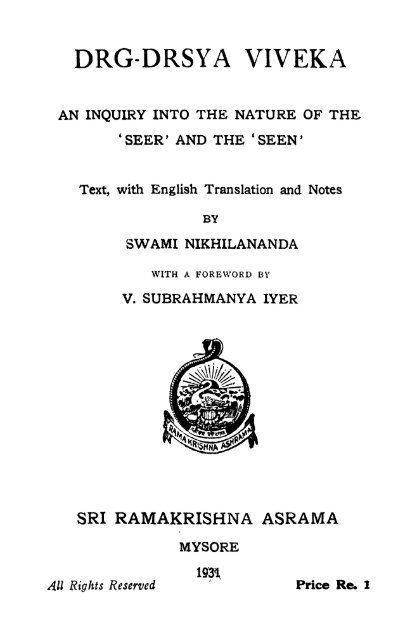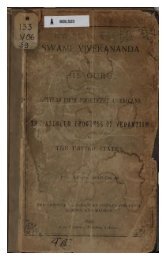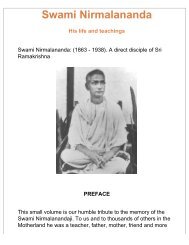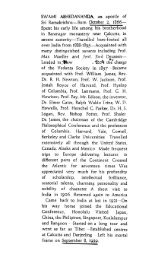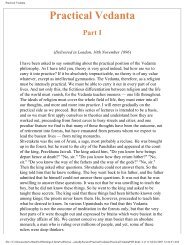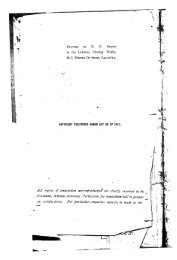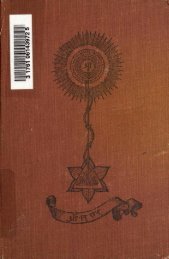DRG-DRSYA VIVEKA - Swami Vivekananda
DRG-DRSYA VIVEKA - Swami Vivekananda
DRG-DRSYA VIVEKA - Swami Vivekananda
- No tags were found...
Create successful ePaper yourself
Turn your PDF publications into a flip-book with our unique Google optimized e-Paper software.
<strong>DRG</strong>-<strong>DRSYA</strong> <strong>VIVEKA</strong>AN INQUIRY INTO THE NATURE OF THE'SEER' AND THE 'SEEN'Text, with English Translation and NotesBYSWAMI NIKHILANANDAWITH A FOREWORD BYV. SUBRAHMANYA IYERSRI RAMAKRISHNA ASRAMAMYSOREAll Rights Reserved1931,'Price Re. I
PUBLISHED BYSWAMI SIDDHESWARANANDAPRESIDENTSRI RAMAKRISHNA ASRAMAMYSORE
TOHIS HIGHNESSSRI KRISHNARA'J.A AjJ^ljJEY^R BAHADUR IV,G.C.S.I., G.B.E:;MAHARAJA OF MYSOREIN f!!GH ADMIRATIONOF HIS GREAT DEVOTION TO VEDANTIC TRUTH
viiiFOREWORDIn the past, rigorous Yogic (mystic) discipline,which was not an end in itself, helped toso clarify the mind as to enable it to reasonmost correctly. But such discipline is almostimpossible under present conditions. Themodern mental outlook is pre-eminently scientificowing to the great progress that science hasmade. And the best method of freeing themind from its inaccurate ways of thinking isto imbue itas fully as possible with the scientificspirit.It is therefore only one who possessesa clear knowledge of its methods and resultsi.e., who is able to make reason (Buddhi} thehighest means of enquiry that would be fit toenter upon the study of Vedantic philosophy.For, as Vedanta itself admits its highestTruth (Atman or Brahman) cannot be reachedby any path other than that of Buddhi (reason)and unless the Buddhi issharper than the'Edge of a razor' (Kath. Up., Ill, 12 and III,14), which is also characterized as Mahadhi orMahabuddhi (great or supreme reason) elsewhere(Mandiikya Karika, IV, 89). The Gitaalso supports it in several places (vide X, 10and VI, 21). Further, where Manas and Chittaare used in the sense of Buddhi in Vedanticliterature, they are declared to be the highestmeans of attaining such knowledge (Bri/i.Up,, IV, 4, 19, Mund. Up., Ill, 1, 9, and Kath.Up., IV, 11). Contrariwise, it is expresslystated that neither religion, theology nor mysticpractice is in itself of value in the absence of
FOREWORDIKBi*ddhi(vide Kvth. Up., 1 1 1, 23 and Mund III, 1, 4.)In a word, purity of life, comprehendingthought, word, and deed, is the foremostrequisite for sharpening the Buddhi.Recognizing, therefore, the difficulty of thenature of the study of Vedanta as a whole, someof the leading authorities on it have written anumber of manuals of introduction. Thoughall these -treatises cover the same ground, referto thesame topics of importance, and point to
xFOREWORDthe same goal, yet they differ from each otherin their approach to the subject. Since thesemanuals are meant to lead those in the lowerstages to rational (Buddhi), i.e., philosophicenquiry (Vichara), they largely cover thepreliminary, i.e., the religious, theological andmystic stages of Vedanta, indicating directlyor indirectly the way to the final, i.e., therational means of attaining the goal. All ofthem rely on the authority of Vedic Revelationand mystic or Yogic ecstasy of Samddki. Butthe philosophy, which rises still higher intorealms of pure Reason, is evidently reservedfor more advanced enquiry.The importance of DTg-DT$ya Viveka asan aid to the study of Vedanta has been wellpointed out by the learned <strong>Swami</strong> Nikhilanandajiin his introduction to this translation. Thecentral theme of this work is that Brahman isrealized through mystic or Yogic Samadhi(Concentration). After this state is attained,one can see Brahman wherever one turns one'seyes." Dhabhimane galite vijnate paramatmaniYatra yatra mano yati tatra tatra Samadhayaha "" With the disappearance of the attachmentto the body and with the realization of theSupreme Self, to whatever object the mind isdirected one experiences Sam&dhi"Problems such for instance as how to makesure that after we attain Samadhi whatever we
FOREWORDxisee isthe Supreme Being or Brahman and notanything else, are matters beyond the scope ofthis small treatise.Viveka being very short, itnecessarily compresses much information into asmall space. Detailed explanations are indispensable.<strong>Swami</strong> Nikhilanandaji has sparedno pains to make not only the English renderingaccurate, but also the notes exhaustiveand scholarly, which will be found to be ofimmense help to those who wish to proceed toa higher study of Vedantic philosophy.The <strong>Swami</strong>'s great literary merits arealready so well and so widely known that thiswork of his needs little introduction from laymenlike me. It is a time-honoured belief, abelief as old as the oldest Upanishads, thatVedantic Truth- is best taught by those that liveit, but not by those that merely talk it.Bhagavan Sri Ramakrishna Paramahamsa, the*Real Mahatma' of the late Prof. Max Miiller,was one such rare and great teacher. And theVedantic works that are published by therevered Order of Sannyasins founded by sucha Guru have so great a spiritual charm thatthey make these works most welcome to allearnest seekers after Truth.Mysore. V. SUBRAHMANYA IYER.
INTRODUCTIONDTg*Dr&ya Viveka, as the name indicates,is an inquiry into the distinction of the * Seer '(DTg) and the Seen ''(Dyya\ an inquirywhich is of the utmost importance for theunderstanding of the higher Vedanta Philosophy.The other name by which this treatiseis known is Vakya Suddka ascribed toSankaracharya, which is also the name of acommentary on it. DTg-DTfya Viveka hasbeen acknowledged as a Prakarana treatise of theVedanta Philosophy, i.e., a book which, thoughconfined to a particular aspect of the subjectmatter,explains its chief purpose, viz.* theidentification of Jiva and Brahman, by followingparticular line of argument. The specialfeature of this book is its detailed descriptionof the various kinds of Samadhi (Concentration),the importance of which is always acknowledgedby the students of Vedanta. It has also giventhree theories, necessarily empirical in character,regarding the conception of Jiva(embodied being).This small book of forty-six Slokas, is anexcellent vade mecum for th study of higherVedanta. Sixteen of the Slokas from DfgDfSya Viveka, from 13 to 31 with the exceptionof 14, 21 and 28> are found in a minor
xivINTRODUCTIONUpanishad, called the Saraswati Rahasyopanishad.It does not seem probable that theauthor of DTg-DT&ya Viveka wrote a treatise offorty-six stanzas borrowing sixteen from anotherbook. Neither of the two commentators hasmentioned these sixteen Slokas as quotationfrom the Upanishad in question. Thereforeit seems to us that the author of the Upanishadhas borrowed these Slokas from DT*DT$ya Viveka, which, if true, would indicatethe importance of the book,Three names are generally associated withthe authorship of the book. BrahmanandaBharati, one of the commentators, acknowledgesBharati Tirtha as its author. In some manuscriptsit is found that Ananda Jnana, anothercommentator, salutes in the colophon Sankaracharyaas its author. Nischaladasa, in hisVritti Prabhakara, ascribes the book to Vidyaranya,the celebrated author of Panchadai.We are led to think that the book was writtenby Bharati Tirtha. Brahmananda Bharatiprobably wrote, as some authorities hold, acommentary called Vakya Suddha. BharatiTirtha, the teacher of Vidyaranya, was a Jagadfounded by Sanka-Guru of the Sringeri Mathracharya.The old records of the Math statethat he was the head of the Math from 1328 to1380 A.D. An inscription dated 1340 A.D.states that Harihara I, the ruler of Vijayanagar*and his brothers made grants of land to BharatiTirtha for the maintenance of the Sringeri
INTRODUCTIONxvMath. Probably Bharati Tirtha was alsoknown as Ananda Bharati Tirtha. BharatiTirtha is associated with the authorship of Drg-Df&ya Vivekcii Vaiyasikanyayamala, and a portionof Panchadasi. Vaiyasikanydyamalais ofgreat help to the student in understanding thecommentary of Sankaracharya on the Brahmasutra.There are two commentaries extant ofDrg-Dr$ya Viveka. One is by BrahmanandaBharati and the other by Ananda Jnana orAnandagiri. The book has been translated intoseveral languages. The Bengali translationhas been admirably done by Babu DurgacharanChattopadhyaya, the erudite Sanskrit scholarof Benares, to whom we are obliged for muchof the information given in this introduction.Drg-Dr&ya Viveka, in dealing with certainaspects of the subject-matter, follows a methodwhich may be called rational in that it attemptsto discuss by employing a method which isknown in logic as the method of Agreementand Disagreement or the method of AnvayaVyatireka of the Indian Nyaya system.Thebook, it is hoped, will be of considerable helpto those who wish to pursue the higher studyof Vedanta Philosophy.For the facilityof understanding by theaverage student, we have given, besides themeaning of the words of the text and its runningtranslation, extensive notes mainly collected
xviINTRODUCTIONfrom the two commentaries mentioned above.The Telugu, Malayalam, English, Sanskrit andBengali editions of the book, which we haveconsulted while translating the treatise, have notalways the same reading. We have not followedin toto any of these editions* But Our readingwill be supported by one or the other of thebooks we have consulted.We wish to take this opportunity toexpress our sense of deep gratitude to H. H.Sri Krishnaraja Wodeyar IV, Maharaja ofMysore, for so kindly permitting us to associatethis book with his name. Sri RamakrishnaAsrama at Mysore owes itspresent position ofusefulness to his sympathy and generosity. It1is well known that His Highness noble fatherencouraged <strong>Swami</strong> <strong>Vivekananda</strong> to proceed tothe Parliament of Religions held in Chicago, anevent which has raised India in the estimationof the whole of the civilized world. TheMaharaja's deep knowledge of philosophy.Eastern and Western, besides his remarkableacquaintance with modern science has madehim one of the most cultured and respected ofIndia's rulers.THE AUTHOR.
( <strong>DRG</strong>-DR^YA <strong>VIVEKA</strong>)ll ^ If^ form ^4 (is) perceived 5P3R eye ^ (is)perceiver ?T^ that ^[4 (is) perceived wre mind?^ (is) perceiver sftlrR*- mind's modifications^^T: (are) perceived*TT#J Witness ^ ^ (is)verily the perceiver 3 but f (it) is not ^ itsmodifications is perceived and the Witness (theSelf) is verily the perceiver, 6 But It 7 (theWitness) is not perceived (by any other).The direct and immediate knowledge of Atman orSelf is the means to the attainment of Liberation.The understanding of the meaning the ^of great Yedicstatement '* That thou art " cPc^WST enables one to-( )2
2 <strong>DRG</strong>-DR&YA <strong>VIVEKA</strong>realise the goal of life. The meaning of " That thouart' 7 is correctly grasped by understanding the senseof the words contained in the statement. The firstfive slokas in the treatise4Thou'.explain the significance of1Form The word implies all objects of senseperception.2Eye It stands for all the organs of perceptionsuch as nose, ears etc.3Ptrceiver The eye is perceiver only in a relativesense because it is itself perceived by the mind.4Mind The sense organs, unless the mind is attachedto them, cannot perceive their objects. In a stateof deep sleep the sense organs do not perceive anythingbecause the mind, at that time, ceases to function.5With etc. -This includes Buddhi, Chitta, andAhamkara.Comp. " aTWWWT W^Sf!^ "fa*. VV})My mind was elsewhere ;I did not see. "6 Perceivet The mind is controlled by the consciousSelf.447// The Atman or the innermost Self is theultimate perceiver. If a perceiver of the Atman issought, the enquiry will end in what is known as aregressits ad infinitum. All entities from the grossobjects to the mind are products of Avidya whichitself is insentient (^^r).Hence they also partakeof the nature of insentiency. Therefore they areobjects. The subjective character of some of these isonly relative. But the Self is the ultimate Seer becauseno other seer is known to exist. The knowledge ofthe Knower is never absent.The subject matter of the first slokais explained in detail in the following :
D$G-D$$YA V1VEKAIIllR IIon account ofsuch distinctions as blue, yellow, gross, subtle,short, longetc. srRTT^ifir various ^wr formsthe eye tjCTT as one *fjfa perceives.2. The forms (objects of perception)appear as various on account of such distinctionsas blue, yellow, gross, subtle, short, longetc. The eye,on the other hand, sees them,itself remaining one and the same.The forms etc. are objects of perception whichare varying. That which is constant and changelessis the perceiver. The different objects appear, nodoubt, as distinct from one another. But they areperceived with their changes, because the eye,as perceiver, is a unity. They all belong to onecategory, namely, 3^ or the seen. With referenceto the objects, the eye is the perceiver.The one characteristic of the objects is theirchangeability. Change is possible only in thingswhich are imagined with reference to a substratum,as is the case with the snake, stick, water-line,garland etc., falsely imagined in a rope. Theseideas are subject to change. The characteristic ofthe Seer is unchangeability. The objects changetout their perceiver is constant. The appearances,like the snake etc., change but the rope is constant.
D$G-D$$YA <strong>VIVEKA</strong>IIIThe eye, on account of itschangeablenature* is an object and its perceiver is themind.blindness, dullness and sharp-mindness, ^rwg characteristics of the eye *R:as a unity ^m^ cognizes ^ this *to ears, skin, etc.,^ also sfteq-^r applies.3. Such characteristics of the eye asblindness, sharpness or dullness, the mind isable to cognize because it is a unity. Thisalso applies to (whatever is perceived through)the ear, skin etc.Though the eye is the perceiver in respect of thevarious forms, yet it becomes the object of perceptionin its relation to the mind. The eye is subject tochanges which are perceived by the mind ;for it is themind that thinks * I am blind ' etc. The mind knowsthe changes because it is a unity. This applies to theother sense-organs as well. Though the nose, the skin,the tongue etc. are respectively perceivers with referenceto their several objects, yet they themselves areperceived by the mind. Hence, the mind is perceiverand the sense-organs are objects of perception.IVMind, also like other sense-organs,isan object perceived by another. This isindicated in the following sloka :
VIV&KA:IIIIConsciousness s&r*n desiredetermination and doubt srersRfcfaith and wantof faith tpfaft steadiness and itsopposite ?>.modesty v fr:understanding *ft: fear ^*rr
D$G-D$$YA <strong>VIVEKA</strong>perception and Consciousness is the perceiver.This is because all these changesare perceived by Consciousness. Consciousnessallperceivesthese states becauseit is a unity. These states, thoughdistinct in nature, become unified in Consciousnessor Self.\frrr II ^ IIThis (Consciousness) T s^T% doesnotrise f s^cTH ^ does not set ire increase *r ^rftrdoes not undergo w decay * farfa) does notundergo ^ of itself f^TTKT shines *w on theother hand T%?TT without snw aid (of othermeans) ^F^TR other objects Hm?i illumines.5. This Consciousness 1 does neither rise 2nor set 3 . It does 4 not increase ;nor does itsuffer decay. Being self-luminous, it illumineseverything else without any other5aid.1Conscion$ness It is the eternal Witness of allinternal changes.2Neither rise Rising ' means birth, i.e., coming'into existence of an entity previously non-existent.This cannot be predicated of Consciousness as it is theWitness of even previous non-existence. Otherwise noone will be aw'are of such non-existence. All entitiesfrom the empirical ego to the gross object perceivedhave a previous non-existing state, because theirappearance and disappearance are cognized by consciousness.
3 Set*<strong>DRG</strong>-DR&YA VIVlKA 7Setting ' means disappearance of anexisting entity, i'.*., its becoming non-existent againThis state, though possible for relative entities, cannotbe predicated of Consciousness. No disappearanceor destruction can be cognized without a consciousWitness.4 Does not etc. Every perceived entity of theempirical world possesses six characteristics, viz., birthexistence ), (3?F%c^), growth (ffe), change), decay ( STT^q" )and destruction ( 5TF5T ).But Consciousness has none of the characteristics of aperceived entity. By negating birth and decay, thefour other characteristics are also negated in Consciousness.Growth and decay are only possible forthose entities which have parts. But Consciousness iswithout parts.Everything else -Ail perceived entities. Comp." "it shining,all else shines" (K
<strong>VIVEKA</strong>6. Buddhi appears to possess luminosity 1on account of the reflection of Consciousnessin it.Intelligence (Buddhi) 2 is of two kinds 3 .One is designated egoity (^tff^O, the other asmind1Luminosity The Conscious Selfthough self-luminous, has no manifestation, becausefrom the absolute standpoint there is no other objectwhich can be manifested by Consciousness. But onaccount of the superimposition of ignorance (3T%sj[)a modification appears known as mind (3TcT:3RQf)whichthough insentient (sre") (being the product of 3U%3U)appears as conscious on account of the association ofconsciousness or >Uman with it. The Atman appearsas Buddhi when associated with Antahkarana. TheBuddhi, on account of its association with Consciousness,appears to be endowed with agency, will etc.2Buddhi Buddhi or Dhlh or intelligence is theinternal organ which is subject to various modifications.The modification which makes and endows it with agencyetc., is known as Ahamkrii or Ahamkara or egoism.Another modification is known as memory consisting ofvarious faculties by means of which external objectsare perceived. The Buddhi, by itself, is insentientBut its appearance as subject, object and(3f^).the means of perception is possible on account of thereflection of Consciousness (f%^) in it. This reflectionendows Buddhi with the power of perceivingobjects.3Two kinds When Consciousness is reflected inBuddhi it undergoes two main modifications. Theseare^the ego and the mind. The ego implies a subject(3T?3>rT) as well as its mind (3tcT:3ROT). The innerorgan, according to its different functions, is known
,10 D$G-DR$YA <strong>VIVEKA</strong>1EgoIt is associated with the notion of subject,2Identity In the case of a red-hot iron ball,fire and iron appear to be identified with each other.Similarly the reflection of Consciousness, coming incontact with ego, becomes completely identified withit and they cannot be separated from each other. Thisreflection of Consciousness which identifies itselfwith the insentient Ahamkara is what is known as Jivaor embodied being.3Body Which is otherwise inert and insentient,4 Conscious enlity That is, movement etc. areascribed to the body on account of this identification.Consciousness (srsn^FT^l) imparts the appearanceof sentiency to all objects from egoism to the grossbody, because it is the innermost essence of all. Thebody includes the places where the sense-organs arelocated. Therefore there is no separate identificationwith the sense-organ.VIIINow is described the nature of theidentification of Ahamkara with differententities : of the ego
<strong>VIVEKA</strong>IIWitness are of three kinds, namely, natural, 2due to (past) Karma, 3 and due to ignorance,4respectively.1Rgo See ante, sloka 6.2Natural The moment the reflection ofConsciousness and the ego (Ahamkara) come intoexistence, they become identified with each other.The ego manifests itself under the influence of thisreflection. Therefore this identification is callednatural or innate. The experience resulting from thisidentification is," I know " (3?f SfRfft).3Karma The ego identifies itself with a particularbody according to its past acts, virtuous or otherwise.Birth in a particular body is always determined byKarma. The experience resulting from this identificationis," I am man " (3Tf *T3^:).4Ignorance. Ignorance of the real nature ofConsciousness is called here ^ffcf (delusion) which iswithout beginning and cannot be described as * Real 'or * Unreal '. This identification of the Ahamkara(ego) with the Witness (*T[$fT%tF3r)is based only uponignorance ($TTfcf).This identification can be removedonly by knowing the real nature of Consciousness.The experience resulting from this identification is,**I am or exist " IXHow the different identifications ofthe Ahamkara come to an end is thusdescribed :
<strong>VIVEKA</strong>of the mutually related (ego andthe reflection of Consciousness) s^t: of thosethat are taken to be real tffsrg? natural (flWcwrerof the identification) 3 certainly frifa: annihilationsnfer is not possible^ the other two WOTT^Karmawith the wearing away of the (result of)srturw and enlightenment SOTK^ respectively Ref^rdisappear.9. The mutual identification of the egoand the reflection of Consciousness, which 1 isnatural, does 2 not cease so long as they aretaken to be real. The other 5 two identificationsdisappear after the wearing 4 out of the resultof Karma and the attainment 5of the knowledgeof the highest Reality respectively.1Which etc. The moment the ego (3^R) andthe reflection of Consciousness come into existencethey identify themselves with each other.2DJCS not etc. That is, they can never separatethemselves from each other so long as they are takento be real. It is like the reflection of the sun in thewater in a pot. The reflection can never separateitself from the water. The reflection disappears onlywhen the water pot ceases to be.1Other two. The identifications of the ego with thebody and the Witness*Wearing out etc. The identification of the egowith the body is due to the past Karma whose effect isseen in this body that lasts till the Karma continuesto produce its effects. But when the body comes toan end owing to the complete wearing out of the effectsof Karma its identification with the ego automatically
This phenomenon is also observed at the timeof swoon and deep sleep when the effects of Karma areceases.temporarily suspended,cAttainment etc. The identification of the egowith the Consciousness (SRMfcfW?)is due to errorwhich (srffrr) is destroyed only by the attainment ofKnowledge. Knowledge (^H) destroys ignorance(3TKR) and its effects. Ahamkara or the ego is theeffect of ignorance. Therefore it is also destroyed byKnowledge. Hence Ahamkara can no longer identifyitself with the Witness after enlightenment, when itdisappears in Brahman.Thethree kinds of identification described abovedisappear simultaneously when the Jiva realizes itselfas Brahman.XNow isthe^describednature of the Atman as well as itsworld-boundassociationswith the three states, which arepossibleonly when the egoidentifies itselfwith the body : II ?o iiSHI in deep sleep ^l^Rsfr when (thethoughtof) ego disappears %?: the bodyalso 3T%cT*n unconscious wrs; becomesfJfarcrnl: the half manifestation of the ego ^frdream (*RT% is) 5 but *n: full (manifestation):waking state (wfcf is).
14 DfG-D$$YA <strong>VIVEKA</strong>10. In the state of deep sleep, when (thethought of) ego disappears 1 the body also becomesunconscious. The state in which thereis the half manifestation of the ego is called thedream state 2 and the full 3 manifestation of theego is the state of waking.1Disappears The ego merges itself in thecausal ignorance which is characterised by the nonapprehensionof empirical objects. This state in whichthere is no perception of duality is called the state ofdeep sleep. The ego in this state does not identifyitself with the body. The result of past Karma, then, isnot noticed. Therefore we become unconscious of ourbody in that state. Comp.s""(Therefore he who has crossed(^f.that bank) if blind,ceases to be blind ;if wounded, ceases to be wounded: if afflicted, ceases to be afflicted.''2Dream state In the dream state the ego doesnot perceive any object external to itself. The seer,the objects seen and the act of seeing which constitutethe dream experiences are only the mental modificationsof the ego. Compare"There are no (real) chariots in that state, nohorses, no roads (but he himself creates chariots,horses and roads).*' The dream experiences, thoughthey appear during the dream state as outside the bodyof the seer, are known to be only modifications of themind from the standpoint of the waking state. Thereforefrom the waking standpoint the dream state is onlya partial manifestation of the ego.3Full manifestation In the waking state the egoexperiences the gross external objects by means of its
<strong>DRG</strong>-DR&YA <strong>VIVEKA</strong> 15internal organs. The ego and the non-ego whichconstitute the entire world of experience are both cognizedin the waking state. In dream it is the mindalone of the sleeper which appears both as the ego andthe non-ego. Therefore the full manifestation of theexperience covering both ego and non-ego is seen onlyin the waking condition.XIHow the experiences of the wakingand dream states are but the modificationsof mind is described now :the inner organ that is nothingbut a modification (ir%0 faTcT^rSftRT identity withthe reflection of Consciousness ^TFTCTT havingattained ^w in dream ^WTT: ideas ^i^ imagines^ in the waking state srlr: withrespect to the sense-organs ^f|: externali%q^i^ objects 3OT3Rt imagines.11. The inner 1 organ (mind) which isitself but a modification (l%0 identifying2itself with the reflection of Consciousnessimagines (various) ideas 3 in the dream. Andthe same inner organ (identifying itself with thebody) imagines 4objects external to itself in thewaking stale with respect to the sense-organs.1Inner organThis comprises mind (Jf^),mindstuff(fan:), intellect (H% : )an d egoism
isD$G-D$SYA <strong>VIVEKA</strong>2Identify It is like .the identification of theheat (fire) with the iron ball.3Ideas The ideas of the ego and the non-ego aswell as their mutual relationship.4ImaginesWe remember oiir dream experiencesin the waking state. The dream experiences whichhave the same nature as the waking ones are knownto be internal only in the wakmg state. The wakingexperiences are also mere ideas or thoughts of theperceiving mind.XIIThe real nature of the inner organis thus described :fipra ?wr II? R IIegosmthe material cause of mind andTB one *&i&w. of the nature of insen-f&frtiency subtle sf^m the three statesattains wi similarlySTRRT is born W*re dies.12. The subtle^ body which is the2material cause of the mind and egoismis oneand of the nature 3 of insentiency.It moves 4in the three states and is born and it dies.1Subtle body This is the same as the Antahkaranaand is called lingam* because it enables theJiva or the embodied being to realise Biahman. Thissubtle body has been described in other Vedantictexts as composed of seventeen parts, viz., five .organsof perception, five organs of knowledge, five modificationsof prana, mind (*W^[) and intellect
D$G-D$YA <strong>VIVEKA</strong> 172One -The subtle body () and thekarfina are really one and identical, though from theempirical standpoint they appear as different. Likethe water and the wave the Antahkirana (HWIT'O andthe ideas which manifest themselves as powers of knowledgeand activity ($TR3n% and T%3ri3TT% which areon ly 1% or the modifications of the mind) are identical,3Nature etc. It is because the Ariahkarana isthe modification of the Avidya which is of the natureof insentiency. It appears as sentient on account ofits identification with the reflection of Consciousness4Moves etc. The identification with the threestates as well as birth, death etc. can be predicated ofthe ego only and not of Atman or Self who is unassociatedwith these conditions.XIIIThe existence of the material worldTheis a matter of indubitable experience.question arises, what is its cause ? Brahman,which isbeyond all causal relations,cannot create it. Therefore the scripturespostulate Maya as the cause of the appearanceof the universe. This Mayais extre-It cannot be described eithermely illusive.as real or unreal.The best way to describe Mayais towhich is done inexplain its two aspects,the following sloka :H\\ u
18 <strong>DRG</strong>-DZ&YA <strong>VIVEKA</strong>of Maya f^mfrarerc of the nature ofprojecting (creating) and veiling ^faCT twopowers ff without doubt (ztfa exists) T%lrren%:power fosrf^ ^T^I^ from the subtleprojectingbody to the (gross) universe *ro^ world &R{creates .13. Two powers, undoubtedly, are predicatedof Maya, viz., those of projecting 1and veiling.The projecting power createseverything from the subtle 2 body to the grossuniverse.1Protecting This leads one to think of the pureand attnbutelebs Atman to be Viswa, Taijasa andPrajna, associated with the experiences of waking,dream and deep sleep. It is, again, under the influenceof this aspect of Maya that the non-dual Brahmanappears as the manifested manifold.2Subtle body This body consists of seventeenparts. See ante, sloka 12.XIVFrom the relative standpoint, Brahmanispointed out as the cause of theuniverse because the mind seeks a cause.That Brahman is, really speaking, notthe cause, can be seen from the followingsloka which describes the true nature ofcreation :ti ? 11
<strong>DRG</strong>-D.R$YA <strong>VIVEKA</strong> 19of the nature of Brahman sft^nrarinthe entity which is Existence-Consciousness-Blissarwfr in the ocean ^TT%^ like foamsetc. *r^rro^sRn??TT the manifesting of all namesand forms efe'. creation wi is called.114. The manifesting of all names- and4forms" in the entity which is Existence- 5 Consciousness-Blissand which is the same asBrahman, like the foams etc. in the ocean, isknown as creation. 71Manifesting This manifestation is due to theprojecting power of Maya which is potential in Brahmanfrom the causal standpoint.2NamesBy which things are designated.3Forms That which is expressed by a name.Both names and forms are mere forms of thought ascan be understood by the analysis of names and formsexperienced in dream, which are nothing but themodifications of the mind.4Entity Reality is not a void or negation asthe Buddhists contend. The appearance of themanifold cannot be based on an Absolute negation.In empirical experience, every appearance has a positivesubstratum. The illusion of names and formsappears from, and disappears in, Brahman.5Existence etc. These are not positive attributesof Brahman, which cannot be described by word orthought. Words etc. can describe only what isperceived in the perceptual world.Like etc. This illustration is for the purposeof showing the indescribable nature of creation.Foams, waves, bubbles etc. are not separate from the-ocean, because all these are made of the same stuff
20 DgG-D$$YA VIV&KAas water. Again, they are not identical with theocean, because we do make a distinction between theoceanand the waves, etc. Similarly the manifestedmanifold is not separate from Brahman, as the Sruti"says, because no separate universe can be conceived of,which, according to the Sruti, is not of the nature ofExistence-Consciousness-Bliss. Again, from the Srutiwe know Brahman as separate from the world, whichwe perceive to be gross, solid, extended in time and1space, etc. This appearance of the universe as separatefrom Brahman is due to Maya.7Creation Vedanta explains the origin of theuniverse by saying that it is the unfolding of Brahmanthrough Its inscrutable power, called Maya.As the rope appears in the form of the snake, or as theocean appears in the form of foams, waves etc. or asthe sleeping man appears to be living in a dreamworld, so also Brahman appears in the form of theworld. From the causal standpoint, Brahman is boththe material and efficient cause of the world,XVNow is described the veiling powerof Maya:3TTO 5TT%: the other power (of Maya)within ^spRft: ($w) (the distinction) between theseer and the seen (objects) wft: outside ^ alsoafra&fc(3l5) (the distinction) between Brahmanand the created universe amtfifir conceals *nthis power ^fawf of the phenomenal universeT cause (w% is).
DgG-DR$YA <strong>VIVEKA</strong> 2115. The other 1 power (of Maya) conceals2the distinction between the perceiver and theperceived objects 3 which are cognized withinthe body as well as the distinction betweenBrahman 4 and the phenomenal 5 universe whichisperceived outside (one's own body). Thispower (STTTR) is the cause of the phenomenaluniverse.power It is known as the Avarana Sakti(the veiling power) of Maya.2Perceiver The. Witness(lJT$fT)which is the causeof the immediate perception of "I" (see ante, sloka1). It considers itself as the enjoyer etc. by identifyingitself with the gross and the subtle body. Reallyspeaking, it is the relationiess Atman.3Objects It includes everything from the empiricalego to the gross body. The Sakshin is distinct fromthe perceived objects. But the veiling power of Mayadoes not enable us to see the distinction and thereforethe Sakshin appears to have identified itselfwith the empirical ego, mind, sense-organs etc.4Brahman Brahman is said to be of the natureof Existence-Consciousness-Bliss. But through theveiling power of Maya It seems to have identified Itselfwith names and forms and thus appears as objectsof enjoyment.5Phenomenal This is a mere appearance likethat of silver in the mother-o'-pearl.6This e1c t From the highest standpoint there isneither creation nor dissolution. Non-dual Brahmanalone is and always exists. The appearance of themanifold is due to the veiling power of Maya whichconceals the real non-dual nature of Brahman anii
3*31 fllfff f&T ii \\\\g2D$G-Dg$YA <strong>VIVEKA</strong>presents the appearance of the variegated universe. Itis just like perceiving dream objects with which thesleeper at that time is in no way connected. From thesubjective standpoint a man becomes a world-boundcreature on nccount of the identification of the seerwith the mind, sense-organs etc. (object). Ignoranceof the distinction between the subject and the object is*the cause of one'* sufferings in the world.Thoughit is a custom with the Vedantic writers todescribe the veiling power (Avarana Sakti) as prior tothe projecting power (Vikshepa Sakti), the author of thistreatise makes here a departure. Strictly speaking, theAvarana Sakti cannot be said to precede the VikshepaSakn or rtce vosa. For, the effects of both are seen.simultaneously. One cannot be conceived of withoutthe other.XVIThat Maya is the cause of the appearanceof the universe has already beenstated. The question now arises : what isthe nature of Jiva who suffers by the lawof transmigration ? It is the illusory characteristicof the universe that is describedbelow with a view to discuss later on thereal nature of Jiva :of the Witness, 3*cT: in immediateproximity few the subtle body ^r with the(physical) body tffflrelated HIM shines. (Thatsubtle body) f%Ri^T^T^*n^iri: on account of its
D$G-Dg$YA <strong>VIVEKA</strong> 2being affected by the reflection of Consciousnesss^T^rffR^: empirical sfan embodied selfbecomes.16. The subtle body (Lingam) whichexists in close proximity to the Witness(Sakshin)identifying itself with the gross body becomes1the embodied empirical self, on account of itsbeing affected by the leflection of Consciousness.1Empirical self It is that which thinks itself asthe agent, enjoyer etc. Jt is this Jiva that appears todie and be re born etc. But the Sakshin or Atman isbitthless, deathless, immutable and without attributes.XVIIA doubt arises here. The embodiedself is unreal and hence liberation is notpossible for it. Again the Sakshin is everfree; therefore no liberation is necessaryfor it. There is no third entity for whomthe scriptures, pointing to liberation, canbe prescribed. Therefore scriptures becomefutile. The following stanza removesthis doubt by showing that the ideaof the embodied self is falsely superimposedupon the Sakshin or the Witness.aq; n?vsof this (the empirical self)nature of being a Jiva STRRRJ. through superimpositiontfifafa in the Sakshin am also*ffac4 the
24 -<strong>DRG</strong>-D%$YA <strong>VIVEKA</strong>appears Wim of the veiling power 5 but f^RSTOT bythe annihilation, *f% the difference *n% havingbecome clear ^ that (the idea of being Jiva),a?wr% disappears.17. The character of an embodied selfappears through false 1 superimposition in theSakshin 2 also". With the disappearance of theveiling power, the distinction 4 (between theseer and the object) becomes clear and with itthe Jiva character of the Sakshin (Witness) disappears.51False supfrtmpositton This is due to the projectingpowers of Maya.2Sakshin Thereby the Witness appears as theworld-bound Jiva*3Also Though the Sakshin is ever free from alltaint of worldliness.4Distinction Through Knowledge one realizesthat the Sakshin is ever free from worldliness and is theeternal seer and all other ideas, trom the empirical egoto the body, are mere objects and hence negatable.5Disappears This is possible only throughKnowledge which one acquires from the study and theunderstanding of the scriptures. Hence scriptures arenot futile.XVIIIAs in the case of the subject itselfthe Sakshin, through false identification,appears to have become the Jiva, so alsoBrahman appears to be identified with theobjective universe.
D$G-D$$YA <strong>VIVEKA</strong> 255W Scoffer *R*flIST ftft IH U \\cmr similarlyTT which ^rra: powerof'Brahman and phenomenal universe ^? distinctionsrric^ concealing mfo exists 3&zm1throughits influence % Brahman ftScK^ as being ofthe nature of modification STTORT appears.the in-18. Similarly, 1 Brahman, throughfluence of the power 2that conceals the distinctionbetween It 3 and the phenomenal universe,appears as endowed with the attributes 4 ofchange.1Similarly As in the case of the Witness andthe object, with reference to the individual self.2Power The concealing power of Maya3 // The real nature of Brahman is that It iswithout attributes.4Attributes The six attributes of the manifestedmanifold, m., birth, existence, growth, change, decayand annihilation. Under the influence of Maya,Brahman appeals to possess these attributes and to beidentified with the world.XIXWhen that veiling power is destroyed,the distinction between Brahman and thephenomenaluniverse becomes clear andthen the changes etc. attributed to Brahmandisappear.
26 <strong>DRG</strong>-D$$YA <strong>VIVEKA</strong>III*. IIin this case also 3?nr%?fT^T with thedestruction of the veiling powerffjRnHrr. ofBrahman and the phenomenal universe 5r^:distinction T%*m% becomes clear era: therefore^f in the phenomenal universe fro*: changeexists 5T not swfa in Brahman ^i%^ everchange exists).19. In 1 this case also, the distinctionbetween Brahman and the phenomenal universebecomes clear with 2 the disappearance of theveiling power. Therefore change 3 is perceivedin the phenomenal universe, but never in Brahman.1/;/ etc.-k$ in the case of the individual self.2With etc. As the result of the knowledge ofthe non-dual Brahman.3Changeetc. Whose essential characteristicsare birth, growth, decay etc.In the foregoing stanzas we have seen, followingthe methods of agreement and difference, that the word"&" ("Thou" in the Vedic statement, "That ThouArt '0 indicates the Witness (Sakshin) which is immutableand changeless arid that the word "
DQG-DR&YA <strong>VIVEKA</strong> 27XXNow is shown the identity of " Thou "'and "That":II Ro ||(it) exists *TTirr (it) shines (becomescognizable) fo4 (it is) dear ^f form *m name^ f[% af^rq^ all these five aspects (characterizeevery entity).W?I?R the first three (are)r characteristics of Brahrnan ^^ the nexttwo ^^1 characteristics of the universe.20. Every entity has five characteristics,viz., existence, cognizabilily, 1 attractiveness,form and name. Of these, the first threebelong 2 to Brahman and the next' 1 two to theworld.1Cogmzabihty That which makes one aware ofthe existence of an object.2Belong fo etc. These three characteristics correspondto Sat, Chit, and Ananda.3Next two Names and forms are the chief characteristics ofMaya.XXIThe meaning of the preceding slokais made clearer in the following by themethods of agreement and difference :
28 D$G-D$$YA <strong>VIVEKA</strong>in the Akasha (ether), air,fire, water and earth ^fiwwroi^g in gods,animals and men *TT%^ra^T: (the attributes of)Existence, Consciousness and Bliss affiwr:common features ^IJTORT forms and namesdiffer.21. The attributes of Existence, Consciousnessand Bliss are equally present in the1Akasha (ether), air, fire, water and earth as wellas in gods, animals and men etc. Names andforms make 2 one differ from the other.1Equally etc.All objects such as a pot, a pictureetc. have these common features. These are theuniversal characteristics.2Make etc. We distinguish one object from anotheronly by their names and forms. Names and formsare characteristics of the individual and hence relative.Even after the negation of names and forms, thereexists the common substratum whose nature is Existence-Consciousness-Bliss(Absolute).XXIIThus following the methods of agreementand difference, we get the impliedmeaning of "a*" ("That") and " ri "(" Thou ") which points to the SatchidanandaBrahman. Therefore Brahman isidentical with the Jiva. But one shouldpractise concentration (Samadhi) in orderto strengthen this conviction. The methodsof Samadhi are described below :
BRG-DR&YA <strong>VIVEKA</strong> 29:\\^ \\(to) name and form 5 two OT^ beingindifferent ^rf^^R^rRqr: (*RO being devoted toSatchidananda f^ ^r either in the heart, STSRT or3rf|: outside *f^r always *wrf3rshould practise.concentration ^ft^22. Having 1 become indifferent to nameandform and being devoted to Satchidananda",one should always practise concentration 3within the heart 4 or outside. 5either1Having etc. Names and forms areimpermannte,because they appear and disappear. Though namesand forms give the direct meaning (^pEZJTST) of "That'*and "Thou" (?4), yet they are negatable as foundin deep sleep.2Satchtdanauda This is the implied meaning(e5^n^f)of all objects. The characteristics of Existence,Consciousness and Bliss are universal and thereforethey form the common features of the substratum of allobjects comprehended by "That" and "Thou".Therefore these aspects alone, being permanent, asdistinguished from names and forms, are worthy ofconcentration.8Concentration Concentration or Samadhi meansthe one-pointedness of the mind by which the studentfeels his steady identity with Brahman.4Heart Heart is pointed out, for the facility ofconcentration, as the seat of Paramatman,Outside That is, concentration can be practisedthrough the help of any external object; such as &
30 D$G-D$$YA <strong>VIVEKA</strong>word, sound, image or any other symbol. These twomodes of concentration are meant for different.temperaments.XXIIISamadhi with its twofold division isdescribed in the following seven stanzas.Concentration within the heart is describedin the three following:\\\\\\in which the ideas are present,in which ideas do not exist ffe (to bepractised) within the heart swrfa: concentration(?fa) ferlR: of two kinds *rfo*7: 3*m%: concentrationin which ideas are present s^rssfig^Fraccording to its association with a cognizableobject or with a sound (as an object) 5*f: againfirm (are) ol two kinds.23. Two kinds of Samadhi to be practisedin the heart (within one's self) are knownas Savikalpa 1 and Nirvikalpa. 2 SavikalpaSamadhi isagain divided into two classes,according to its association with a cognizableobject or a sound (as an object).1Savikalpa In this Samadhi, the practitionerconcentrates his mind on Brahman without completelylosing such distinctions as the knower, knowledgeand the known. This is the initial step in the practiceof concentration.
<strong>DRG</strong>-DR&YA <strong>VIVEKA</strong> 312Nirvikalpa In this Samadhi the practitionermakes himself free from all thought of distinctions,as the knower, knowledge and the known.XXIVNow is described theSamadhi (Savi-in which concentration is associatedkalpa)with an object.centred in the mind WJTOI: desireetc. S^T: (cognizable) objects %?R ConsciousnesscJc*w%^R as their Witness ^T%^ shouldmeditate are this sspngftss;. (is) combined withcognizable objects srifoeTO: in which ideas arepresent *wfa: concentration.24. Desire 1 etc. centred' 2 in the mind areto be treated as (cognizable) objects. Meditateon Consciousness 8 as their Witness. 4 This iswhat is called Savikalpa Samadhi associatedwith (cognizable) objects.1Desire See an!e y 4.2Centred etc. Because they are the modificationsof the mind. They disappear with the disappearanceof the mind as in deep_ sleep. Therefore, they havegot nothing to do with Atman.Consciousness It means Atman, that is, theWitness of all these mental modifications.4. Witness Because of the presence of Atman,the mind and its modifications are seen to be active.
32 <strong>DRG</strong>-DZ&YA <strong>VIVEKA</strong>Then the processof the meditation is this : Wheneverany thought appears in the mind, take it to bean object and be indifferent to it. But think of theAtman as your real nature, eternal and permanent.The object which is an idea appears and disappears.This sort of concentration is always associated withan object of thought.XXVNow is described a higher kind ofSavikalpa Samadhi, with which some soundassociated:(object) isI) aflfrr: unattached *HW^; Existence-Consciousness-Bliss^sw self-luminousfree from duality 3fl%T am ?% are this(is) associated with words ^f^Fra: *wfa:Savikalpaka Samadhi,25- I am ExistenceMTonsciousness-Bliss, unattached, 2 self-luminous 3 and free 4from duality. This is known as the (otherkind of) Savikalpa Samadhi associated withsound (object).1Existence etc. Sat, and Ananda are thejChitnatural characteristics of Atman,2Unattached Unrelated to Chitta or mind whosefunctions are seen as desire, volition etc. Atman isalso unattached to virtue and \ice, weal and woe,(relative) knowledge and ignorance etc. Comp, "S"This Purusha is unattached.''
D$G-D$$YA VIVZKA 333Self-luminous The existence of Atman canneverbe doubted even when the relative objects areabsent as in deep sleep. Compare " 3?g 5?(I. S. V*-
34 <strong>DRG</strong>-DR&YA VIV^KA26. But 1 the Nirvikalpa Samadhi is that inwhich the mind 2 becomes steady like the (unflickeringflame of a) light kept in a place freefrom wind and in which the student becomesindifferent to both 3 objects and sounds onaccount 4 of his complete absorption in the blissof the realization of the Self.1But The Nirvikalpa Samadhi is here distinguishedfrom the Savikalpa Samadhi as described inthe foregoing slokas.2Mind etc. Through the constant practice of theSavikalpa Samadhi, mind becomes free from all distractionswhich is the icsult of attachment to sense-objects.Therefore he, then, becomes competent to practiseNirvikalpa Samadhi in which the mind becomes steadylike the unflickering Jiame of a candle kept in a windlessplace. Compare*lcT11As a lamp in a spot unsheltered from the wind,does not flicker, even such has been the simile usedfor a Yogi of subdued mind, practising concentrationin the Self."3Both etc. These are associated with concentrationin the Savikalpa Samadhi. Desires etc. are thecognizable objects and " J am unattached " etc. aresound (objects) or ideas.4On account etc. The word Anubhuti, in the text,means " Highest Consciousness " or " Self ".Comp.
<strong>VIVEKA</strong> 85" I bow to that innermost (Subjective) Self, birthless,incomprehensible, infinite, the embodiment ofBliss and the background of the World, created byMahat etc. and painted by ignorance (Maya)/'The word * Rasa ' means the Supreme Self or thenature of the Highest Bliss. Comp. "^r^T: l**rMfaW*T3TF%" (ft S. VvM). "He is the Rasa,tor only after perceiving a flavour can any oneflavour,become blessed."The word Avesa means complete absorption. Orit may mean the 'manifestation' of the Supreme Bliss.in the heart as the index of success in the SavikalpaSamadhi. Another meaning of the word *is coming 'trom (Slifcr) all directions (su)of bliss. Still anothermeaning is the 'possession' i.e. the practitioner becomespossessed, as it were, by the bliss of self-realizationand can no longer control himself.The Nirvikalpa Samadhi is the highest kind ofconcentration in which the practitioner realises hisreal Self. In this Samadhi the functions of the mindare stopped and the practitioner experiences theHighest Bliss. CompareFffi" The mind, with the utter quiescence of modificationsconferring upon one Supreme Bliss, is saidto be Asamprajnata Samadhi that is dear unto theYogis."This Samadhi is characterized by the absence ofthe knowledge of the subject-object relationship.Apparently it is like that state of calmness andtranquillity which pervades a stone, because in the
36 DZG-DR&YA V1VEKANirvikalpa Samadhi the mind stops its functioning.But it should not be mistaken for stupor or deep sleepin which state alone one experiences absence ofduality. The difference between deep sleep andNirvikalpa Samadhi is that in the former state thereis no knowledge of Self, but in the latter thereexists no feeling of not knowing the Self, because inthe Nirvikalpa Samadhi one becomes identified withthe ever-Conscious Atman. Compare"The state in which all desires completely disappearwhich is (quiescent) like the interior of astone, but which is not characteiized by _swoon ordeep sleep is admitted as the real nature of Atman.'*Nirvikalpa Samadhi which is identical with theHighest Knowledge can be attained only as a resultof discrimination between the real and the unreal,After this discrimination, the student becomes indifferentto everything of the lelative world. Comp.Sutra, Samadhi Pada,16). "That is extreme non-attachment, which gives upeventhe qualities and comes from the Knowledge of (thereal nature of) the Purusha."This Samadhi is possible only for him who has becomeestablished in complete renunciation. Comp.44Success is speedy for the extremely energetic."In this Samadhi one becomes free from all thoughtsor ideas but infilled with Supreme Bliss. CompareII
<strong>DRG</strong>-<strong>DRSYA</strong> VIVE KA 37'*It is just like an empty pitcher placed in thesky, having nothing inside and outside ;and again;it is just like a full pitcher placed in the sea, full (ofwater) both inside and outside.XXVIIBy the practice of Samadhi describedabove the practitioner realises his own Selfwhich is of the nature of Existence-Consciousness-Bliss.But this concentrationcan also be practised with the help of anyobject in the external world. By suchconcentration one can realise the nature ofBrahman and creation.are identicalBrahman and Selfn?vs iias in the heart sn^^rsfa in the externalregion as well 11%^ *GPR& ^gfr in any objectwhatsoever arra of the first kind swrftwRi; concentrationis possible tf: that (Samadhi) ^JTI^TT^Erom the Pure Existence (which is Brahman)the separation of names and forms.27. The first 1 kind of Samadhi is possiblewith the help of any external 2 object as it iswith the help of an internal 3 object. In thatSamadhi the name and form are separated 4fromwhat is Pure Existence 5 (Brahman).1First kind etc, i.e.theJSavikalpathe help of an objectSamadhi with
38 D$G-D$$YA <strong>VIVEKA</strong>2External By concentration on such external*objects,as the sun etc.3Internal etc. Such as desire etc.4Separated Names and forms on account oftheir appearance and disappearance are negatable.This is done by concentration on the Satchidanandafactor of an entity.5Pure Existence The Existence aspect of anobject can never be negated.We have seen in the 24th stanza that concentrationcan be practised with the help of an objectperceived internally. Similar concentration can bepractised with the help of an external object also.Every object, as we have seen, has three unchangeableaspects, namely, Existence, Visibility, and Attractiveness.The two other changing aspects are namesand forms. The practitioner should concentrate hismind on Pure Existence which is the same as Brahmanand dissociate himself from the changing aspects ofname and form.xxvinNow is described the other kind ofSavikalpaka Samadhi (^igr%[) associatedwith sound (object) to be practised with thehelp of an external object :\\\t\\of the same nature (always) andunlimited (by time, space etc.) ^ftr^WF^asfdrcharacterised by Existence-Consciousness-Blissentity (flfam that is Brahman) 5%
<strong>DRG</strong>-DR&YA <strong>VIVEKA</strong> 39tt such uninterrupted reflectioamiddle, *T*TTT%: concentration *fa^ is.28. The entity which 1 is (always) of thesame nature and unlimited (by time, spaceetc.) and which is characterised by Existence-Consciousness-Bliss, is verily Brahman. Suchuninterrupted reflection is called the intermediate2 absorption, that is, the SavikalpakaSamadhi associated with sound (object).Which is etc. Which remains the same, that is,immutable in the past, present and future and whichis,not limited by time, space etc.~Intermediate,Because it is superior to theSamadhi described in the foregoing Sloka and inferiorto the Nirvikalpa Samadhi.This Samadhi is similar to the one describedin Sloka 25. The only difference is that it is associatedwith an external (objective) idea whereas theother one is associated with an internal (subjective)idea,XXIXNow is described the NirvikalpakaSamadhi which can be practised byfollowingthe objective method :nfrom the experience of Bliss:^insensibility (to externalas in the previous instanceobjects)
40 <strong>DRG</strong>-DR&YA <strong>VIVEKA</strong>the third kind of Samadhi *RT: described3Ri by the teachers) T^ : q^fa: swifafo:by thehelp of these six kinds of Samadhi T%T^FCalways *BT time *nr^ should spend.29. The insensibility1of the mind (toexternal objects) as 3 before, on account of theexperience" of Bliss, is designated as the thirdkind of Samadhi (Nirvikalpaka). The practitionershould uninterruptedly spend his time4in these six 5kinds of Samadhi.1Insensibility This shows that the mind iscompletely absorbed in the contemplation of Brahman.~As before As in the case of Samadhi describedin the twenty-sixth Sloka ; here also the practitioner attainsthe Nirvikalpaka Samadhi by merging the entireillusory phenomena in Brahman and by being indifferentto the manifested manifold (^3$) and suchideas as " indivisible " (a?^:),of the same nature(tpB?3f:) etc. Concentration becomes steady like theunfiickering flame of a candle in a place free fromwind.3Experience etc. This bliss is due to the knowledgeof Brahman whom the scriptures describe as anentity of Bliss. The Self (subject) is identical withBrahman. In the subjective concentration, the Selfwhich is the Witness of all mental modifications isidentical with Brahman. Otherwise such concentration,without a substratum, becomes a mere mentalabstraction and ends in nihilism. Again, in objectiveconcentration, Brahman, the unchanging entity in allperceived objects, because of its all-pervasive nature,is identical with the Self (subject). As the knowledgeof Brahman is associated with bliss so also theknowledge of Self is accompanied by Bliss Eternal.
<strong>VIVEKA</strong> 414Uninterruptedly This Samadhi should bepractised uninterruptedly for a long time. Then onlycan the practitioner be firmly established in supremeknowledge. Cf. (*T) "^t^reA^4^^R%ftd1wqftr: "(TT. %, *fflTIT7I3;, vsv)."It becomes firmly groundedby long, constant efforts with great love (for the endto be attained)."Six That is, three subjective and three objective.5XXXAs a result of the constant practiceof Samadhi, described above, it becomessubsequently quite natural and spontaneous.Then the student realises Brahmaneverywhere.TfoScTthe attachment to the bodywith the disappearance of TOTc^fa the SupremeSelf (MricT (HT%) with the realization of ^^^r^rto whatever objects *R: mind ^TRT goes rr^TrT^rthere ?r?n>w. absorptions (^r^cr are).30. With the disappearance of the attachment1 to the body and with the realization ofthe Supreme Self, to whatever object- themind is directed one experiences Samadhi.*1Attachment etc. On account of such attachmentto body, a being feels that he is a man, a Brahmin,a so and so, etc. Following the process of enquiryJaid down in Vedanta, the student realises that all
42 DfG-DgSYA <strong>VIVEKA</strong>internal entities from the empirical ego to the bodyare only objects and the subject (Self) is the Witness.Therefore, he ceases to identify himself as attachedto the objects, knowing that appearance and disappearanceare their inevitable nature. Similarly, by ananalysis of the external world he realises that Brahmanis the only permanent entity in the universe,while names and forms are changing phenomena.Therefore the practitioner becomes indifferent to theInternal and external objects and fixes his mind onBrahman which is identical with the Self.2ObjectsAs perceived by the senses.Samadhi That is, as a result of constant piactice;Hof Yogic Samadhi, as described above, for a longtime and with the help of the knowledge of Truth, thepractitioner realises all objects, internal and external,as Brahman. Even the names and forms which appearto the ignorant as devoid of reality are looked uponby the Jnani as ever existent Brahman. He sees everywhereBrahman only. The knowledge of Brahmanwhich is at first attainable by effort becomes, later on,quite spontaneous and natural.XXXINow is described the result of thisrealization in the language of thesupremeMundaka Upanishad (2-8):\\\\ \\.Him who is high and low & bvbeholding i*pmfrr: fetters of the heart firmeris broken flWswr: all doubts fiteRt are solved
D$G-Df$YA <strong>VIVEKA</strong> 43His Wffa ^ all works' (and their effects)wear away,31. By 1 beholding Him who 2 ishigh andlow, the fetters 3 of the heart are broken, all 4doubts are solved and all 5 his Karmas (activitiesand their effects) wear away.1By beholding Him That is, by realisingBrahman throughout the manifested manifold.2Who is high and low The word high (q*[)signifies Brahma, what is known as cause of the universe.The word low (3^) signifies the universe etc.which are the effects. It is the non-dual TurlyaBrahman alone that exists everywhere, both in thecause and in the effect.3Fetters etc. This denotes ideas of agency etc.which are falsely superimposed on the Self. This isdue to ignorance.4All doubts That is, the doubts regarding thenature of Self.*AlUiis Karmas etc*~-For a Jnani the accumulatedworks as well (4f%cT3$r)as fresh works (3Tf*nT*rar) donot yield any result. Only the fructescent works(5tt^*'T3*T), as a result of which a man has got hispresent body, continue to produce their result. Thiswork yields its result so long as the body lasts. Butthis explanation is offered only from the standpoint ofthe ignorant who see even a Jnani subject to disease,misery, hunger, thirst etc. But a Jnani who has madehimself quite free from the body-idea does not feel theeffect of any Karma. For him all works and theireffects are non-existent. Comp. " arerftf n^cf ^f&nfoft*2STff:" (ST. s. olvs^). "(But) when he is free of thebody, then neither pleasure nor pain touches him."
44 <strong>DRG</strong>-DR&YA <strong>VIVEKA</strong>He who realises Brahman attains liberation-which is the highest objective of life. Compare the.following Sruti passages :%5 ^ira" **%" (3. s. vv>)"sra*14He who knows Brahman, verily, becomes Brahman/'"srefa^raficf TO*" (I. 3\ Wl)14The knower of Brahman attains the Highest."44The knower of Self goes beyond grief. ""3f^q | 3RcR Simtsfi-r ;> (f. S. V-1-v)44Oh !Janaka You have attained fearlessness. "!''TTrfW^ ^8ra5T^T%I% M (f. ^. v-V^X)44Oh, (Maitreyi), thus far goes immortality. "44Knowing it (Self) one goes beyond death/'"33RTSSI ^R^TS^ M (f. 5T. VV-^3)"When the Self only is all this."XXXIIWe have seen the method prescribedin this treatise for the realization of theHighest Truth. By following this methodthe student understands the real significanceof 4< That " and " Thou " and ultimatelyrealises that identity. All thesehave been described in their proper places.The various helps for the attainment ofhave been dealt with assuch knowledgewell as the result of the knowledge ofidentity.The treatise may be said to be
<strong>DRG</strong>-DR&YA V1VEKA4Scompleted here. But' a doubt may stillarise in the mind of the student. Whatis the nature of Jiva? If the Witness(Sakshin) is really Brahman, then He cannotbe Jiva. And if He is Jiva, then Hecannot be Brahman. In any case, theteaching is of no use. Therefore, it isnecessary to explain to the student thereal nature of Jiva.The student will be told in the followingslokas that the Jiva in reality is Sakshinand identical with Brahman. The Sakshinconsiders itself to be Jiva owing to hisidentification with the Upadhis :limited f%^mm: unreal presentationof Consciousness g^fto: ^sw^cr. the thirdis as imagined in dream ^KT T%iV
46 D$G-DRYA <strong>VIVEKA</strong>of Prana, sense-organ, mind etc. and thus jegardshimself as Jiva. It is like the infinite space (Akasha)portions of which appear to be limited by pots etc.According to the second theory, the Consciousness(Sakshin) appears to be fallaciously presented in themind and this presentation is known as Jiva. It islike the reflection of the sun in water.The reflectionalways partakes of the qualities of the medium inwhich it is reflected as the reflection of the sun is seento be moving etc. with the movement of the water.Similarly, the presentation of Consciousness in themind partakes of the qualities of the mind, such asagency, desire, volition etc. According to a thirdtheory, the nature of Jiva is the same as the nature ofvarious beings one sees in dream. In dream, onaccount of the absence of the knowledge of reality,one thinks _pfhimself as king, god, or beggar etc.Similarly, Atman, also, through the ignorance of itsreal nature, thinks of itself as man, or animal etc.According to the author of this treatise, the firsttheory (3ftft3W3:)tells us that the real nature ofJiva is Brahman. This view is, however, not acceptedby all schools of Vedanta.XXXIIIHow is itpossible for a limited entity(Jiva) to be identical with the AbsoluteBrahman ? This is thus explained:3 ^RPRT: II unlimitation ^rer: w^ isimaginary
<strong>DRG</strong>-DR&YA <strong>VIVEKA</strong> 47on account of superimpositionthe Jivahood appears 3 butnaturally 5TO
48 Z)gG-Df$YA <strong>VIVEKA</strong>3Jivahood The appearance of Jiva is not possiblewithout the association of upadhis. The followinganalogy of a scholiast is interesting. Rahu always existsin the firmament. But it cannot be directly perceivedexcept in association with the solar or the lunar disc.Similarly Sakshin also becomes an object of perception(Jiva) only in association with egoism, Prana etc.// is etc. The Sakshin is the same as Brahman.It may be contended that if the idea of limitation(Jivatvam) and what limits it (Prana etc.) be unreal,then Sakshin also (what appears to be limited) is unreal.But this contention is refuted thus: Sakshin is notunreal because it is the same as Brahman. A womanwearing anklets, through illusion, considers her feetto be entwined by a snake. With the removal of theillusion, the snake idea vanishes: but her feet remainas they are. Similarly the illusion of limitation andwhat limits, is removed by Knowledge. But theSakshin always exists.XXXIVThat the theory of limitation (aexplains in a better way the identity ofJiva and Brahman than the two othertheories, is now described :such Vedic statements as" That Thou Art" etc. sref^w ^RW of thelimited Jiva
<strong>DRG</strong>-DR&YA <strong>VIVEKA</strong> 4934. Such Vedic statements 1 as "ThatThou Art" etc. declare 2 3the identity of partlessBrahman with the Jiva who appears as suchfrom 4 the standpoint of the 'Theory of limitation'(3T^t%^r?:). But it does not agree with the 5'other two views (of Jiva).Vedic statements The four great Vedic statementswhich summarize the entire teachings of tlvVedas are :(1) "That Thou Art " (cTr?W%) ;(2) "I ABrahman " (3?f 5f^TI%f); (3) "This Atman is Brahman ^.(3T?F 3TRTT 3?l) ;(4) "(Pure) Consciousness is Brn _man" (siffR 5fr). s \2ifijjare etc. The method followed in arriv fa"at surDecfoclusion is what is known as *n*n?n*Tc5$nJT' Je-T a method in which the / ofon both sides are given ir T alltheir l(*el*Y^1 Js recognized, noticing caiefulessence of \^\^^ j s chj t or pure Consr\ 3pi*i jresenta!-flv ^ > ^ 5-rW/cjj Btahman i.e., Pure Conscio^-j L^4 'From the eiL"That is, the Jiva as^ ancj eniOVS 2Theory of limitation" which decla* f- A J ,^ n'limited by the Upadhis orJ*vaAvidy., ,appears as Jiva. .eilts' 5 and their5 ~v 7 rp,*ature of theThe otherobjectsJetc..There ar / ,of Jiva ^ one in which he (universe).:apandthe other in which ' .,.. ... . ,'^^^o^* 4* ^ o-i ac " as cultivation, trade,presentation of the Seik^r ., r r i . ..^ ,T-f,r t *i T-* the Vedas, spiritual practitjtyof these^Jivas, acrtreatise, with Brahma>For, they have no rev in this world or in heaven.mere imagination. , . -theory of limitatk her air fire ' water and earth -5 .-Various animate and inanimate objects.
50 D$G-D$$YA <strong>VIVEKA</strong>Brahman can be demonstrated. But the two otherJivas are illusory. There cannot be any identitybetween an illusory appearance and a real entity.XXXVThat the appearance of Jiva is due tothe limitation(jBrahman is thus described :(^^:) superimposed uponunrv ^ *^we ^[fc^J^^lf flW^^faf Sffi^rat II ^to;aiilluasIIf^qr^rrf^iWr 5TRT Maya character id byu oiection and concealment ^W^ in a^^manMaya which has the dou6ie-v??erjtexplai'rfiP is in 2 Brahman.Jiva and indivisible nature of Brahmantheories, is Prahman) appear as the worldbeing.^nte.lo." That Thou Art" etc..suchfor the cause of''vare told that it (Maya)without parts tr^ri identity *3- *^rc ^^T; with the two other Jivas.y e Jnwnat-J r TA i ^^ JDUt" * jrests ^ra^ m Brahman *F Udi->le nature ^Ti^^r having concea'.. ^^itrc Inihe world and the Jiva, sre?^ agines.af e?IS-
<strong>DRG</strong>-DR&YA <strong>VIVEKA</strong> 51xxxvrWhat is the nature of Jiva and whatis, again, the nature of the universe ?The answer is thus stated :\\\\\\located in Buddhi (mind)fallacious presentation of Consciousness *&-f^the performer of activities HTTRT (^) (as well as)the enjoyer f| because (cTOT^ therefore) *for:^fftrai becomes Jiva ^rptrraffi consisting of elements(^p) and their products (*ft%i) ^Tnr^q- ofthe nature of the objects of enjoyment & ^ allthis, *FKt universe ^rra: is called.36. it is because the fallacious presentationof Consciousness (f%5WRp.) located in theBuddhi performs various 1 3actions and enjoystheir results, therefore it is called Jiva. And allthis, consisting of the elements 3 and theirproducts 4which are of the nature of the objectsof enjoyment,is called Jagat (universe).1Various actions Such as cultivation, trade,sacrifice, worship, study of the Vedas, spiritual practicesetc.2Enjoys Either in this world or in heaven.3Elements Ether, air, fire, water and earth.4ProductsVarious animate and inanimate objects.
52 D$G-DR$YA VIVERAXXXVIIBoth Jiva and Jagat are the productsof;Maya hence they are cognized so longas a man is in a state of ignorance.^ 3$ these two *TWc
<strong>DRG</strong>-<strong>DRSYA</strong> <strong>VIVEKA</strong> 53Till one etc. The world 'disappears when oneattains liberation or Jnanam. Compare1iSTW(3- s. VV*)"Their fifteen parts enter into their elements, theirDevas (the senses) into their (cortesponding) I)evas.Their deeds and their Self with all his knowledgebecome all one in the Highest Imperishable."orEmpirical The Jiva and Jagat are neither realnor illusory (SfTfavufa^). They are empiricalphenomenal (2TT^[TR^).XXXVIIIThe following doubt arises : if theindividual self, as weil as the cognizeduniverse, existing from time immemorial,should last till one attains liberation, howis itpossible to explain the scripturalpassages dealing with creation, preservationand destruction and also waking,dream and deep sleep states? It is thusexplained :ftsrlocated in (associated with)Consciousness as wrongly presented fa$nrr?rofthe nature of projection and concealmentsleep $ at first sftwRft the (individual)
54 <strong>DRG</strong>-DZ&YA <strong>VIVEKA</strong>self and the cognized universe anw coveringg~r new but 3***^ imagines.38. Sleep, said to be associated withConsciousness wrongly presented (in the mind)and of the nature of concealment and projection,at first covers the (empirical) individual 1 selfand the cognized universe, but 2 then imaginesthem (in dream) afresh. 3Individual etc. The individual self and the1universe whose existence is perceived in the wakingstate.2 But This is to show the distinction betweenthe Jiva and Jagat perceived in the waking state(Vyavaharika) and those of the dream state (Pratibhasika).3Afresh That is, the Jiva and the Jagat cognizedin dream which are apparently different from those ofthe waking state.One of the scholiasts explains the Sloka in the:following wayNidra means Avidya, that is, a state in whichis not known. This Nidra orthe nature of realityAvidya merges (^T^T-SffeT^F^r) everything within itat the time of deep sleep or cosmic dissolution ; Jiva,again, imagines them afresh at the time of waking.The ^ord "imagines" means that they again becomeobjects of experience. Jiva or the Chidabhasa beingitself a creation of Avidya cannot properly be said tobe the ground (3Tf9RT) of Avidya. But from commonexperience, " I am ignorant"(3T? 3T|F;),such expressionmay be used,It is on account of the belief in causality thatthe mind sees a causal relation between the experiencesof the waking and the dream states.
XXXIX"V1VEKA 55*Why are the Jiva and the Jagat, ascognized in dream, imaginary or illusory?^ ftTTCT these two Jftfttfara tpf rc*RRrr?t on accountof their having existed only during the periodof (dream) experience ^1^11%% illusory (&&&are called) f| because *?rcrsf^ for one whohas woke up from sleep ^m in (new) dreamcRt: of those (Jiva and Jagat) 3?r: again f&ftr:existencer not (seen).39. These two objects (namely, theperceiving self and the perceived world) areillusory on account of their having existed only 1during the'pferiod of (dream) experience. It isbecause no one after waking up from clreamsees those objects when one dreams again.1Only These objects do not exist during thesubsequent waking or clienni states.From this analogy it can be said that the entireworld of experiences, perceived as real during the stateof ignorance, are illusory or imaginary on account oftheir non-perception after the attainment of Knowledge.XLThe following three stanzas point outthe difference between the Jivas as conceivedfrom (he three standpoints statedabove:
56 D$G-n$$YA V1VEKA^: who (is) sifcWTftra: illusory (that isperceived in dream) ^: Jiva fa: he) ^ thatTnftrwfM) illusory (perceived in dream) *m^world ^Tr4 real *r^cf thinks g but spar. other^ETSFRSJ: empirical ^fan Jiva (Unreal To the Jiva of the waking state theentire dream-perceived world of subject and objectappears as unreal.The dream and the waking experiences, on accountof their mutual contradictions, cannot be saidto be real.Now isXLIdescribed the nature of experiencesof the Paramarthika (Real) Jiva:
<strong>DRG</strong>-DR&YA <strong>VIVEKA</strong> 57*: who (is) *n*roftsfc empirical ^T*C: JivaH: he ^ that ^I^TT^E empirical *r*r^ world^f real srwrf sees : the real (Jiva)that) ftrwrr ?f% unreal *T-ar% thinks.41. He who is the empirical1Jiva seesthis empirical 2 world as real. 3 But the real 4Jiva knows it 3Lto be unreal.Empirical See ante, sloka 36.Empirical The world of waking experiencescreated by Maya.*Real As existing in past, present and future.It is because the relative world exists as long as theJiva, its perceiver, exists.Real Jiva The Jiva that is the witness of thethree states,5//The world and its experiences in thewaking state.Because such world and its experiencesare not perceived in deep sleep.XLIIThe ParaiYiarthika Jiva as distinguishedfrom the Jivas of the waking anddream experiencesis identical with Brahman.I^ nthe real Jiva 5 but 5T$M iden-with Brahman TrwnShS real stt% knowstity
58 D$G-Dg$XA VIVZKAother ?r sft$r% doeiPttot see STWC^T as unreal5 but ^faffi" sees.42. But the Paramarthika Jiva knowsits identity with ;1,Brahman to be (alone) real.He does not see the Other, 1(if he sees the other)2he knows it to 1>e ffetisory.1Other He;doefr not see any existence otherthan Brahman.
<strong>DRG</strong>-DR&YA(experiencer of the dream. state) on accountof their being products of Avidya, areinsentient by nature. Then how can theybe described as Jiva For ? Jiva is the sameas the Jivatma as the Sruti "says, Enteringby this living; self" (Chand. Up.6-3-2, 3). The Brahman itself has enteredinto the Devata (shining element), of thenature of fire, earth, water, in the formof a Jivatma and manifested differentnames and forms. The doubt is thussolved :Rffa*m*r% ii 99 nsweetness, fluidity and coldness,tfftWT: characteristics of water crfr% in thewave f3^wr inhering m%%%ff in the foam ofwhich it (wave) is the substratum 3?ft also w3?3*ffiT as inheres *nf&W: the inherent characteristicsof Sakshin ^?m-?T: Existence, Consciousnessand Bliss ^r?n
60 DgG-D$$YA <strong>VIVEKA</strong>foams of which the waves are the substratum,so also Existence, 2 Consciousness and Blisswhich are the (natural characteristics of Sakshin)appear to H inhere in the Vyavaharika Jiva 4 onaccount of its relation 5 (with Sakshin) andthrough it similarly inhere in the PratibhasikaJiva.1Waves The substratum of waves is water. Thecharacteristics of the substratum appear to inhere inthat which is substrated. The water appears as wavesand the waves as foams. There is no differencebetween them except in respect of names and forms.Again, the foams, waves and water cannot be separatedfrom sweetness, fluidity and coldness. The substanceis, according to Vedanta, the same as the quality.2Existence etc. These are the natural characteristics(^T^T^^fJF) of Sakshin or Brahman. As a matterof fact, Sakshin is identical with Satchidananda.3To inhere in It is because the VyavaharikaJiva, including the perceived universe, is the illusoryappearance (Aropila) falsely superimposed upon Brahman.Therefore the characteristics of Brahman appearto inhere in the Jiva and the Jagat.4Jiva Both the Vyavaharika Jiva and thePratibhasika Jiva include the worlds or the non-egosperceived in the waking and dream states.5Relation This relation is seen from t'he causalor relative standpoint. From the standpoint ofBrahman there is no Jiva, Vyavaharika or Pratibhasikaand hence no relation.flPratibhasika Jiva Both the ego and the nonegocognized in dream also have the characteristics ofExistence, Consciousness and Bliss.
<strong>DRG</strong>-D%$YA <strong>VIVEKA</strong> 61XLVThis is how the characteristics ofAtman are superimposed (srsjrcnr) upon theseer and the seen. Now comes the negationof this erroneous superimposition.jq with the disappearance of thefoam craptff: its characteristics SSRTT: such asfluidity etc. in the water fciBi% exist.'45. With the 1disappearance of the foam(in the wave), its characteristics such as fluidityetc. merge in the wave; again with the disappearance61' the wave in the water, these characteristicsmerge, as 3before, in the2water.1Foam This is an appearance. The waveappears as the foam.~Wave This is' also an appearance of water,.which is the ultimate substratum.8As before Fluidity, coldness and sweetness werewhat constituted water before waves and foams appeared.Now after the disappearance of wave and foam inthe water, these characteristics are also found to existin their antecedent forms, as water from which theycannot be separated. Water always exists. Foams etc.have no existence separate from water. They appearfrom and disappear in water. They are nothing butwater in another form.
62 D%G-DR&YA VtVEKAXLVINow the meaning that we get fromthe illustration isapplied to the objectillustrated :errsrfa n ^ n^r with the disappearanceof the Pratibhasika Jiva (sft^R^r: the characteristicsof Existence, Consciousness and Bliss)in the Vyavaharika (empirical) Jivaexist rf?R with the disappearance of thatcharacteristics of Existence, Consciousnessand Bliss mqw in Sakshin
<strong>DRG</strong>-DR&YA <strong>VIVEKA</strong> 63mergence of the Pratibhasika Jiva and the VyavaharikaJiva in Sakshin (that is, in Brahman at the time ofdeep sleep and Mukti respectively) the characteristics,such as Existence etc. inhering in them, disappear inBrahman. For names and forms as well as thecharacteristics belonging to them have no otherexistence apart from Brahman. They appear out ofand disappear in Brahman Brahman or Sakshin. Itsexistence cannot be denied, in the past, the present orthe future nor in the states of waking, dream or deepsleep. The Vyavaharika Jiva and the world that itperceives are non-existent before creation and afterdissolution. They exist only during the period ofignorance. They appear out of Brahman, inhere inBrahman and finally disappear in iiiahman. As foamand wave have no existence apart from water, so alsothe entire universe consisting of the ego and the nonegohave no existence apart from Brahman. Verily allthat exists is Brahman.


